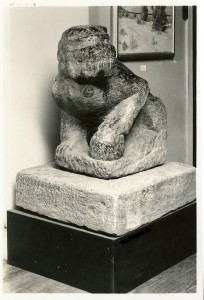After the second week of May, I readily began my Senior May Project, an intensive program that allows second semester seniors to explore a field of study for three weeks. Pulling open the imposing silver doors of the Cranbrook Archives on my first day, I had no idea what truly occurred on the other side. As I, with the fumbling hands of a novice, used fundamental archival tools such as finding aids, vertical and photo files, indexes, backlogs, and the digital image database over the course of the three weeks, I began to understand what an archivist does behind those argent doors.
Honestly, it is a lot of filing. Archivists receive chaotic and often decaying papers, photographs, and other documents deemed worthy of being preserved, and they organize them into various categorizes and topics. Everything has a place, and that place is well recorded in differing indexes and inventories. As a person whose nickname as a child was “Messy Meg,” I inevitably struggled to learn the complex organizational system. Often, I would stand in a dim corner of the archives, afraid of disarranging the gray archival boxes like some omnipotent entropic force, or a two-year-old. Thus, in the second week when I was tasked with organizing three filing cabinets of photographs from Cranbrook Kingswood post-merger, I inwardly panicked. Once I removed the folders, I discovered that they were in complete disarray from the disinterested teenager who had supposedly organized the cabinets before me. While their quite arrogant lack of effort often made me want to pry my muscles from my bones, it also relieved my anxiety, for I knew no matter how badly I mismanaged the cabinets, it would never be nearly as appalling as it was prior.
After finishing the cabinets, I helped Ms. Edwards rummage for posters in the metallic archive vaults, and there in James Scripps Booth’s yellowing, rigid pastels, I discovered why an archivist undertakes all that grueling and mind-numbing filing. Beneath the waxy paper shielding the drawings, nude female figures innocently and exquisitely revealed themselves among impatient pastel strokes. While I was beguiled by the striking beauty of the sketches, I was equally as captivated by their ability to reveal the whims of Booth. Thus, not only the women, but Booth as well lay exposed. Such drawings and degenerating documents that archivists strive to preserve are like little vitrines displaying various aspects of the past. Each frame depicts a story and when all the frames combine, a larger impression is formed. Like an ink blot, this impression allows the viewer to decide what the greater story is. The ability to interpret the past for yourself is a rare and remarkable privilege, and that was the greatest gift my time in the archives gave me.
– Margaret Harney, CKU ’15












